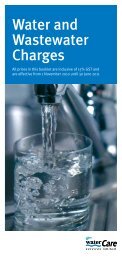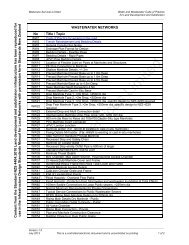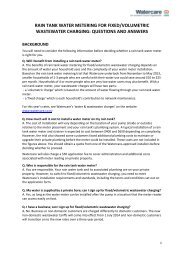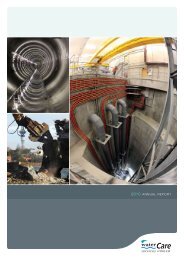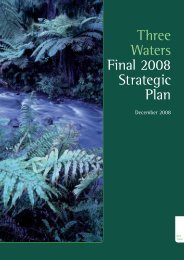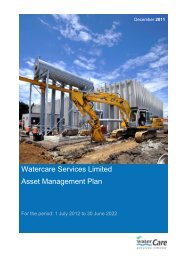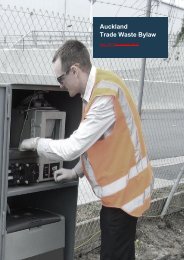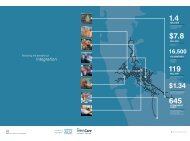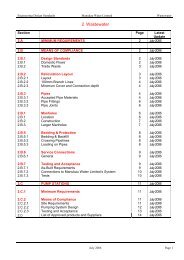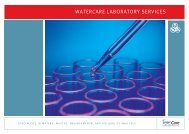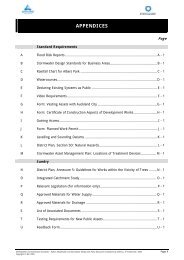Annual Report 2011 - Watercare
Annual Report 2011 - Watercare
Annual Report 2011 - Watercare
You also want an ePaper? Increase the reach of your titles
YUMPU automatically turns print PDFs into web optimized ePapers that Google loves.
<strong>Watercare</strong> Services Limited<br />
<strong>2011</strong> ANNUAL REPORT<br />
Onehunga<br />
gas explosion<br />
Early on Saturday 4 June <strong>2011</strong>, many<br />
New Zealanders woke to the news that there<br />
had been a serious accident at a construction<br />
site in the suburb of Onehunga, Auckland.<br />
<strong>Watercare</strong>’s Network Maintenance Planner<br />
Philomen Gulland, 48, was killed and several<br />
of her colleagues were injured when an<br />
explosion occurred during an inspection<br />
of a 1.9-metre-diameter pipe which had<br />
been drained of water. The fire service later<br />
identified the presence of gas, and the<br />
police, fire service and Department of Labour<br />
launched inquiries. Additionally, <strong>Watercare</strong><br />
commenced its own review.<br />
Four <strong>Watercare</strong> staff members and<br />
contractors required hospital treatment.<br />
One of these, Network Engineer Ian Winson,<br />
47, suffered serious injuries.<br />
Chief Executive Mark Ford described the<br />
accident as “a very dark hour for <strong>Watercare</strong>”,<br />
noting at the time: “These people are like<br />
family to us”.<br />
The accident occurred at a construction site at<br />
the intersection of Mt Smart Road, Victoria Street<br />
and Athens Road, where contractors earlier<br />
that morning had completed the removal of a<br />
section of the Hunua No. 3 watermain that had<br />
been drained and withdrawn from service. A<br />
new section of pipe was to be linked as part of<br />
a project which will ultimately connect a new<br />
watermain, Hunua No. 4, to the existing network.<br />
At the time of the accident, Philomen and her<br />
colleagues were commencing a condition<br />
inspection of a section of the drained pipe.<br />
The project work and the inspection had been<br />
scheduled for Queen’s Birthday Weekend as<br />
this is typically a time of low water demand<br />
in Auckland.<br />
Philomen, a Canadian-born mother-of-two,<br />
was a popular and well-respected <strong>Watercare</strong><br />
staff member. Several hundred friends,<br />
family and colleagues attended a gathering<br />
to farewell Philomen at Auckland’s Waipapa<br />
Marae. In a notice in The New Zealand Herald,<br />
her colleagues recalled her professionalism,<br />
generosity and laughter, and said she would<br />
be sorely missed.<br />
At a committee meeting on 9 June <strong>2011</strong>,<br />
members of Auckland Council observed<br />
a minute’s silence and expressed their<br />
condolences to the families of Philomen and<br />
to the others who were injured, recording<br />
that this was <strong>Watercare</strong>’s first lost-time injury<br />
accident in 18 months.<br />
Construction work has since been completed<br />
and the watermain has been returned to<br />
service with the new connection in place.<br />
<strong>Watercare</strong><br />
at work<br />
<strong>Watercare</strong> team aids Christchurch recovery<br />
<strong>Watercare</strong> sent a 28-strong response and<br />
recovery team to Christchurch following<br />
the devastating earthquake that struck the<br />
city on 22 February <strong>2011</strong>.<br />
Christchurch relies on groundwater. Prior to<br />
the earthquake, the groundwater was not<br />
treated and therefore the city’s water utility<br />
provider did not have disinfection facilities<br />
or expertise in this area. With the threat of<br />
groundwater contamination, the Medical<br />
Officer of Health decided it was necessary<br />
to chlorinate the water to lower the risk to<br />
public health.<br />
In the days that followed the earthquake,<br />
<strong>Watercare</strong> set up its containerised mobile<br />
Onehunga gas explosion<br />
chlorine dosing rig to disinfect water at the<br />
largest pump station. This rig had been built<br />
following the earthquake in September 2010<br />
and, while it was not needed then,<br />
it was quickly pushed into action this time.<br />
<strong>Watercare</strong> also designed and oversaw the<br />
production, installation and commissioning<br />
of 26 chlorine dosing rigs that were used<br />
at the high-risk pump stations.<br />
Operations Manager Wastewater<br />
Mark Bourne says the <strong>Watercare</strong> team set<br />
up a depot in Christchurch and secured a<br />
local contractor to assist with the build of<br />
the units.<br />
“After the units were pressure tested,<br />
we installed and commissioned them before<br />
handing them over to the council.” While the<br />
majority of work was based<br />
around water supply, a team of fitters<br />
and instrument technicians was based<br />
at Bromley Wastewater Treatment Plant<br />
to carry out emergency repair works.<br />
<strong>Watercare</strong> laboratory staff also helped<br />
the council with water-quality testing.<br />
The staff worked on a rotational basis<br />
over the course of four weeks.<br />
PAGE 14<br />
North-Western Water Supply Manager Priyan Perera beside one of the pump stations that was affected by the February earthquake.<br />
Return to Contents page




